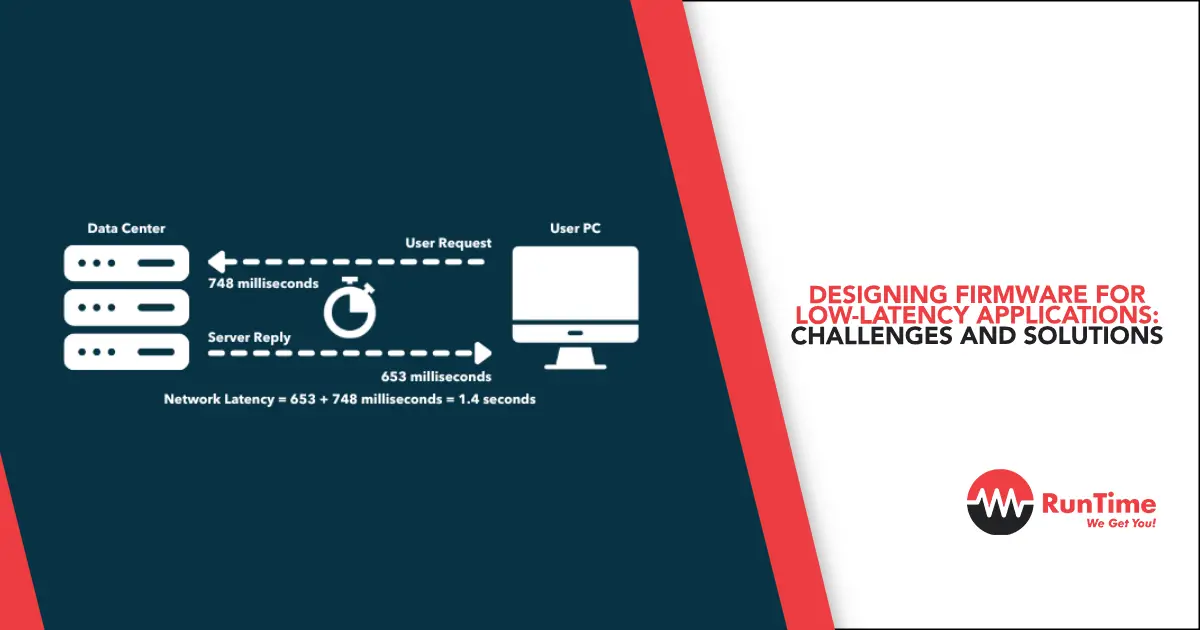Designing firmware for low-latency applications presents a unique set of challenges that require innovative solutions to meet the stringent performance demands of modern technology. In a world where speed and responsiveness are critical, the pressure to minimize latency in firmware design is greater than ever.
This article delves into the complexities faced by engineers when developing firmware for low-latency applications, exploring the intricacies of balancing real-time processing requirements with limited resources. From optimizing code efficiency to reducing interrupt latency, every aspect of firmware design plays a crucial role in achieving the desired level of responsiveness.
By examining the key challenges and proposing effective solutions, this discussion aims to provide valuable insights for engineers striving to deliver high-performance firmware tailored for low-latency applications. Join us as we unravel the complexities of firmware design in the pursuit of minimizing latency and maximizing efficiency in cutting-edge technology.
Exploring Low-Latency Challenges
Impact of Hardware Limitations
In this section, we delve into how hardware limitations play a crucial role in achieving low-latency systems. Explore how factors such as processing power, memory, and network capabilities impact the ability to meet real-time processing requirements. Hardware limitations can significantly affect the overall performance of low-latency systems, as they dictate the speed and efficiency at which data can be processed and transmitted. Understanding these limitations is essential for organizations looking to optimize their systems for low-latency applications.
Meeting Real-Time Processing Requirements
Discover the intricacies of meeting real-time processing requirements and the challenges that come with ensuring data is processed and delivered in the shortest time frames possible. Real-time processing demands quick decision-making and rapid data processing to keep up with the pace of incoming information. Organizations need to implement efficient algorithms, scalable infrastructure, and robust networking solutions to meet these stringent requirements while maintaining high levels of accuracy and reliability.
Addressing Timing and Synchronization Hurdles
Uncover the complexities involved in addressing timing and synchronization hurdles in low-latency systems. From clock drifts to network latencies, we discuss the various obstacles that can affect the accuracy and reliability of real-time data processing. Timing discrepancies can lead to data inconsistencies and errors, emphasizing the importance of precise synchronization mechanisms and timing protocols. Organizations must deploy synchronization techniques such as NTP (Network Time Protocol) and PTP (Precision Time Protocol) to ensure accurate timing across distributed systems, minimizing synchronization errors and optimizing low-latency performance.
Advancements in Hardware Technology
Recent advancements in hardware technology have paved the way for enhanced low-latency systems. The development of specialized processors, high-speed memory modules, and efficient networking components has enabled organizations to overcome traditional hardware limitations. By leveraging cutting-edge hardware solutions, businesses can achieve higher levels of performance and responsiveness in their real-time applications, ultimately enhancing the overall user experience.
Optimizing System Architecture for Low-Latency
Optimizing system architecture is paramount for achieving low-latency objectives. By designing streamlined architectures that minimize processing bottlenecks and reduce data transmission delays, organizations can create efficient systems capable of meeting demanding real-time processing requirements. Implementing parallel processing techniques, data caching mechanisms, and load-balancing strategies can further enhance system performance, enabling seamless data processing and transmission with minimal latency.
Future Trends in Low-Latency Solutions
Looking ahead, the future of low-latency solutions holds promising developments. Emerging technologies such as edge computing, 5G networks, and advanced data processing algorithms are poised to revolutionize low-latency systems, offering faster processing speeds and improved responsiveness. As organizations continue to push the boundaries of real-time applications, staying abreast of these technological trends will be crucial for maintaining a competitive edge in today’s fast-paced digital landscape.
Strategies for Achieving Low-Latency Firmware
Achieving low-latency firmware is crucial for ensuring optimal performance in embedded systems. To meet the demands of real-time applications and devices, developers must employ a combination of efficient coding practices and hardware optimization techniques. Let’s delve deeper into the strategies that can be adopted to achieve low-latency firmware.
Enhancing Code Efficiency
Enhancing code efficiency is the cornerstone of low-latency firmware development. By focusing on writing clean, optimized code and leveraging advanced data structures and algorithms, developers can significantly reduce processing time. Techniques such as loop unrolling, data caching, and code refactoring play a vital role in streamlining the firmware codebase. Additionally, employing compiler optimizations and minimizing code bloat are essential steps in enhancing code efficiency. Continuous integration and unit testing are also crucial to ensure that code changes do not inadvertently introduce latency issues.
Implementing Real-Time Operating Systems (RTOS)
Real-Time Operating Systems (RTOS) are instrumental in achieving low-latency firmware by providing deterministic task scheduling and prioritization. RTOS offers a preemptive multitasking environment that ensures critical operations are executed within specified time constraints. Tasks in an RTOS environment are assigned priorities, allowing developers to allocate resources effectively and manage latency-sensitive processes efficiently. Furthermore, RTOS facilitates inter-task communication and synchronization, enabling seamless coordination between different modules in the firmware. Implementing RTOS-specific design patterns such as periodic tasks and interrupt service routines (ISRs) can further enhance the responsiveness of the firmware.
Utilizing Hardware Acceleration Methods
Hardware acceleration methods offer a significant performance boost by offloading compute-intensive tasks to specialized hardware components. Field-Programmable Gate Arrays (FPGAs) and Graphics Processing Units (GPUs) are commonly used for accelerating computations in firmware. By harnessing the parallel processing capabilities of hardware accelerators, developers can achieve remarkable reductions in latency. Tasks such as image processing, signal analysis, and neural network inference benefit greatly from hardware acceleration, enabling rapid response times in firmware applications. Exploring emerging technologies like neuromorphic hardware can also open up new possibilities for further reducing latency in specialized applications.
A multi-faceted approach that combines code optimization, real-time scheduling, and hardware acceleration is key to achieving low-latency firmware. By adopting these strategies and staying abreast of advancements in embedded systems technology, developers can create responsive and efficient firmware solutions that meet the stringent latency requirements of modern applications. Embracing a culture of continuous learning and experimentation in firmware development is essential to staying competitive in the ever-evolving landscape of low-latency embedded systems.
Section: Case Studies and Innovative Solutions
Minimizing latency has become a critical aspect of ensuring optimal performance in various systems. This blog section will delve into some compelling case studies and innovative solutions that have successfully addressed latency challenges in different industries.
Success Stories in Latency Mitigation
The Finance Sector: Overcoming Milliseconds
- Explore how a leading trading firm managed to reduce latency significantly through novel network infrastructure upgrades and algorithmic optimizations.
Gaming Industry: Seamless User Experience
- Discover how a popular online gaming platform enhanced user experience by implementing advanced content delivery networks and real-time data processing capabilities to mitigate latency issues.
Healthcare Applications: Critical Time-sensitive Solutions
- Delve into how cutting-edge healthcare applications are leveraging low-latency solutions to enable real-time monitoring, diagnostics, and treatment delivery. Explore case studies where telemedicine platforms have transformed patient care by minimizing delays in data transmission and ensuring prompt medical interventions.
Innovations in Low-Latency Firmware Design
Autonomous Vehicles: Real-Time Decision Making
- Uncover how cutting-edge firmware design in autonomous vehicles has revolutionized real-time decision-making processes, enabling swift responses to dynamic road conditions while maintaining a high level of safety.
IoT Applications: Enhancing Connectivity
- Learn about the latest innovations in low-latency firmware design for Internet of Things (IoT) applications, facilitating seamless connectivity and rapid data transmission for a diverse range of smart devices.
Edge Computing: Powering Near Real-Time Applications
- Explore how edge computing solutions are reshaping the digital landscape by bringing processing power closer to the data source, reducing latency for applications that require instant responses. Discover use cases where edge computing has enabled real-time analytics, remote monitoring, and autonomous operations.
Innovative Approaches to Latency Mitigation
Quantum Computing: Redefining Speed Limits
- Delve into the fascinating realm of quantum computing and its potential to revolutionize latency mitigation by leveraging quantum entanglement and superposition to process data at unprecedented speeds. Explore how quantum algorithms are being developed to tackle complex latency challenges across industries.
5G Technology: The Future of Low Latency
- Discover how the emergence of 5G technology is set to redefine low-latency standards, enabling ultra-fast data transmission and real-time communication for a wide range of applications. Learn about the impact of 5G on latency-sensitive industries such as autonomous vehicles, augmented reality, and telemedicine.
Machine Learning Optimization: Intelligent Latency Reduction
- Uncover how machine learning algorithms are being utilized to optimize system performance and reduce latency in real-time applications. Explore case studies where predictive analytics and AI-driven decision-making have led to significant improvements in response times and overall efficiency.
The Future of Latency Mitigation
Predictive Latency Management: Anticipating Performance Needs
- Explore how predictive analytics and proactive latency management strategies are shaping the future of performance optimization in latency-sensitive systems. Learn how predictive modeling and adaptive resource allocation are being used to anticipate and address latency issues before they impact user experience.
Cross-Industry Collaboration: Synergizing Solutions
- Discover the power of cross-industry collaboration in developing innovative latency mitigation solutions. Explore case studies where knowledge sharing and technology transfer between sectors have led to groundbreaking advancements in reducing latency and improving system responsiveness.
Regulatory Considerations: Balancing Latency and Compliance
- Delve into the complex interplay between latency requirements and regulatory compliance in industries such as finance, healthcare, and autonomous systems. Learn about the challenges of meeting stringent latency targets while ensuring adherence to data protection and safety regulations.
Stay tuned as we continue to explore the evolving landscape of latency mitigation, uncovering new trends, technologies, and best practices that are shaping the future of high-performance systems across industries.
Future Trends and Industry Impact
Implications for Diverse Sectors
- Healthcare Industry Transformation: Personalized Care and Remote Monitoring
- Automotive Industry Innovations: Autonomous Vehicles and Smart Transportation Solutions
- E-commerce Adaptations: Enhanced Customer Experiences and Targeted Marketing Strategies
- Entertainment Sector Evolution: Immersive Experiences and Content Personalization
The future of technology is rapidly evolving, with low-latency technologies playing a pivotal role in shaping various industries. Advancements in low-latency technologies such as edge computing and 5G networks are redefining speed, efficiency, and connectivity. Edge computing is shifting data processing closer to the source, enabling real-time decision-making and reducing latency. Similarly, 5G networks are revolutionizing connectivity by offering faster speeds and lower latency, thereby enhancing communication and IoT capabilities.
Moreover, artificial intelligence (AI) and machine learning (ML) are playing a crucial role in driving automation and decision-making processes across industries. AI-powered solutions are enabling businesses to streamline operations, enhance productivity, and deliver personalized experiences to customers.
These technological advancements have far-reaching implications across diverse sectors. In the healthcare industry, they are facilitating a transformation towards personalized care, remote monitoring, and predictive analytics. The automotive sector is witnessing innovations such as autonomous vehicles, smart transportation solutions, and connected car technologies.
E-commerce platforms are adapting to these trends by focusing on enhancing customer experiences, implementing targeted marketing strategies, and leveraging AI for personalized recommendations. The entertainment sector is evolving to offer immersive experiences, interactive content, and personalized recommendations to engage audiences.
The future trends in low-latency technologies are reshaping industries and driving innovation at an unprecedented pace. Embracing these advancements will be crucial for businesses to stay competitive, deliver value to customers, and foster growth in a rapidly changing digital landscape.
Looking ahead, the integration of low-latency technologies with Internet of Things (IoT) devices is poised to create a more interconnected and responsive ecosystem. This convergence will lead to enhanced smart city solutions, efficient energy management systems, and improved industrial automation processes. The seamless communication facilitated by low-latency networks will pave the way for more sophisticated applications in smart homes, healthcare monitoring devices, and autonomous machinery.
Furthermore, the deployment of 5G networks will not only revolutionize consumer connectivity but also enable transformative changes in manufacturing and supply chain management. Real-time data analytics powered by low-latency technologies will optimize production processes, enhance quality control measures, and enable predictive maintenance in industrial settings. The convergence of 5G with augmented reality (AR) and virtual reality (VR) technologies will unlock new possibilities for immersive training programs, remote collaboration tools, and interactive customer experiences.
As industries continue to adopt these advanced technologies, the landscape of work and business operations will undergo significant transformations. The demand for skilled professionals adept at navigating the digital realm will rise, prompting educational institutions and training programs to incorporate curricula focused on emerging technologies. Businesses that proactively embrace these future trends will not only gain a competitive edge but also contribute to the evolution of a more interconnected and efficient global economy.
Regulatory Considerations
In this section on regulatory considerations, we will delve into the intricate world of compliance and standards crucial for low-latency firmware. Low-latency systems operate on the edge of technological capabilities, demanding strict adherence to industry regulations and standards to guarantee reliability and optimal performance. Let’s explore in detail the essential compliance requirements and industry standards that developers must meticulously follow when conceptualizing and developing low-latency firmware.
Compliance and Standards for Low-Latency Firmware
When it comes to designing low-latency firmware, developers face a myriad of challenges, ranging from meeting latency requirements to ensuring seamless integration with existing systems. Understanding the design guidelines and regulations specific to low-latency firmware is paramount to avoid pitfalls and deliver a cutting-edge solution that meets the stringent demands of modern applications.
Ensuring Data Security in High-Speed Environments
Moving on to data security in high-speed environments, it is imperative to address the escalating concerns surrounding the protection of sensitive information transmitted at high speeds. The rapid transmission of data in high-speed environments exposes vulnerabilities that can be exploited by malicious entities if proper security measures are not in place.
To secure high-speed data transmission effectively, organizations must implement robust encryption protocols, stringent access controls, and continuous monitoring mechanisms. Encryption plays a pivotal role in safeguarding data integrity, while access controls ensure that only authorized personnel have the requisite permissions to access sensitive information.
Navigating the intricate landscape of regulatory considerations for low-latency firmware and ensuring data security in high-speed environments require a proactive approach and a comprehensive understanding of industry standards. By adhering to established regulations and implementing robust security measures, organizations can mitigate risks and foster a secure environment for high-speed data processing.
Expanding on Compliance and Standards for Low-Latency Firmware
Compliance with industry standards such as ISO 13485 and IEC 62304 is paramount for the successful development and deployment of low-latency firmware. These standards provide a framework for quality management systems and software lifecycle processes, ensuring that firmware meets the necessary regulatory requirements and operates reliably in critical applications.
Moreover, compliance with standards like NIST SP 800-53 and GDPR is essential for addressing data privacy and security concerns in low-latency systems. Adhering to these standards helps in establishing robust data protection mechanisms and ensuring compliance with data handling regulations.
Furthermore, staying informed about emerging technologies and regulatory updates is crucial for developers working on low-latency firmware. Continuous education and training on evolving compliance requirements and security best practices enable developers to adapt to changing regulatory landscapes and incorporate the latest security measures into their firmware designs.
Enhancing Data Security in High-Speed Environments
In high-speed environments, data security goes beyond encryption and access controls. Implementing threat detection mechanisms, intrusion prevention systems, and secure coding practices are essential to fortify defenses against cyber threats targeting high-speed data transmission.
Additionally, conducting regular security audits and penetration testing can help identify vulnerabilities in the system and ensure that security measures are effective in safeguarding data integrity. Collaborating with cybersecurity experts and staying abreast of industry trends in data security are vital for maintaining a proactive cybersecurity posture in high-speed environments.
Regulatory considerations for low-latency firmware and data security in high-speed environments are critical aspects that require continuous attention and adherence to industry best practices. By prioritizing compliance with standards, integrating robust security measures, and staying vigilant against evolving threats, organizations can build resilient and secure systems capable of high-speed data processing.
Testing and Validation Procedures
Importance of Robust Testing Protocols
In the realm of software and firmware development, robust testing protocols are crucial to ensuring the quality and reliability of the final product. These protocols involve systematically evaluating the software or firmware to identify any defects or bugs that may impact its performance. By conducting thorough testing at various stages of development, developers can catch issues early on and make necessary corrections, ultimately resulting in a more stable and efficient product.
Validation Methods for Low-Latency Firmware
When it comes to low-latency firmware, validation methods play a critical role in guaranteeing that the firmware operates within the required latency parameters. Validation involves verifying that the firmware meets the specified performance criteria and functions as intended under various conditions. For low-latency firmware, this is particularly important as any delays or inefficiencies can have significant consequences. By employing rigorous validation methods, developers can be confident in the reliability and performance of their low-latency firmware.
Importance of Automated Testing
Automated testing is an essential component of modern software and firmware development processes. It involves using specialized tools to execute tests, compare actual outcomes with expected results, and provide instant feedback on the software’s performance. Automated testing not only speeds up the testing process but also enhances its accuracy and repeatability. By automating repetitive and time-consuming tests, developers can focus on more critical aspects of development and ensure consistent quality across different versions and builds.
Continuous Integration and Continuous Deployment
Continuous integration (CI) and continuous deployment (CD) are practices that aim to streamline the development and release processes. CI involves automatically integrating code changes into a shared repository multiple times a day, allowing developers to detect errors early and resolve them quickly. CD, on the other hand, focuses on automating the deployment process to deliver software updates to customers rapidly and frequently. By implementing CI/CD pipelines, development teams can ensure that each code change is thoroughly tested, validated, and deployed, reducing the risk of introducing bugs and improving overall efficiency.
Performance Testing for Scalability
In addition to functional testing, performance testing is essential for evaluating a software or firmware system’s scalability, reliability, and resource utilization. Performance tests simulate real-world scenarios to assess how the system performs under varying workloads and stress levels. By measuring key performance indicators such as response time, throughput, and resource consumption, developers can identify performance bottlenecks, optimize system components, and ensure that the software or firmware can handle increasing user loads without degradation in performance.
Security Testing for Vulnerability Assessment
Security testing is a critical aspect of testing and validation procedures, especially in today’s interconnected and data-driven world. It involves assessing the software or firmware for potential security vulnerabilities, such as unauthorized access, data breaches, and denial-of-service attacks. By conducting comprehensive security tests, developers can identify and mitigate security risks early in the development lifecycle, reducing the likelihood of exploitation and safeguarding sensitive data and systems. Security testing should be an integral part of the overall testing strategy to ensure that the software or firmware meets the necessary security standards and compliance requirements.
Conclusion
Testing and validation procedures are fundamental aspects of software and firmware development that directly impact the quality, reliability, and performance of the final product. By implementing robust testing protocols, validation methods, automated testing, continuous integration and deployment practices, performance testing for scalability, and security testing for vulnerability assessment, developers can ensure that their software and firmware solutions meet the highest standards of quality and security. Investing time and resources in thorough testing and validation processes not only enhances the end-user experience but also minimizes the risk of defects, vulnerabilities, and performance issues, ultimately leading to successful product launches and satisfied customers.
Designing firmware for low-latency applications presents various challenges that require innovative solutions. By addressing issues such as real-time processing, efficient memory management, and optimizing communication protocols, developers can create firmware that meets the stringent requirements of low-latency applications. It is essential to continuously refine and adapt firmware designs to keep pace with evolving technology and user demands in order to deliver optimal performance in low-latency environments.









